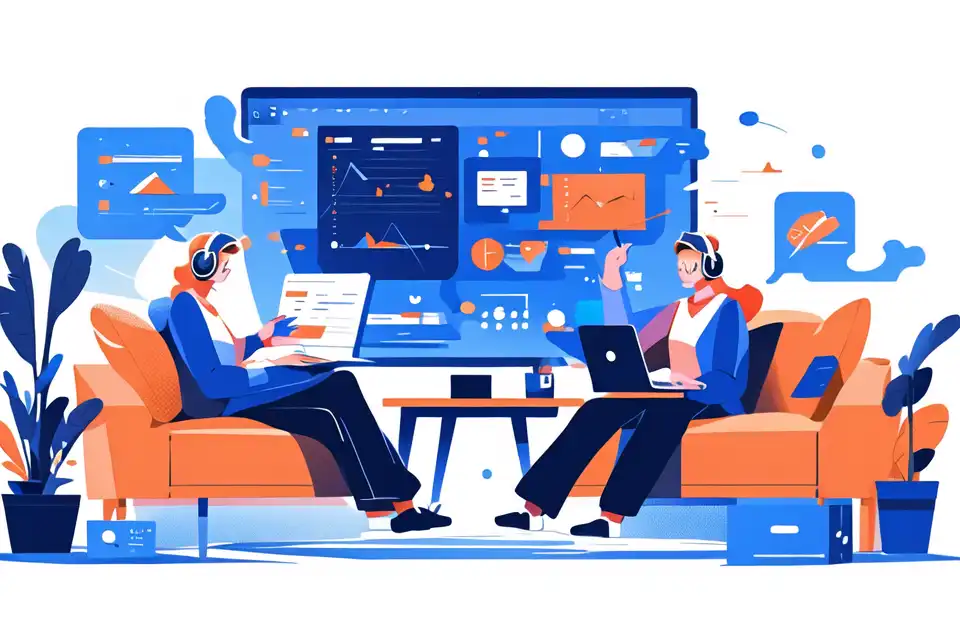Pick Phase
Unlock the potential of Pick Phase with the comprehensive Lark glossary guide. Explore essential terms and concepts to excel in the gaming realm with Lark solutions.
Try Lark for Free
The pick phase is a crucial component of gaming that plays a significant role in both the gaming experience for players and the success of gaming businesses. This phase refers to the process in which players select their characters, abilities, or items before the start of a game or match. In this article, we will explore the definition and relevance of the pick phase in the gaming industry, its significance, who benefits from it, and how it works for gaming businesses. We will also discuss best practices, actionable tips, related terms, and concepts, as well as provide a conclusion summarizing the key takeaways. Let's dive in and explore the world of pick phase in gaming!
Leverage the full capabilities of Lark Base to streamline, oversee, and successfully execute your real estate strategies and initiatives.
Define pick phase and its relevance in the gaming industry
The pick phase in gaming refers to the stage where players choose their characters, abilities, or items before beginning a game or match. It is a crucial part of the overall gaming experience, as it sets the foundation for gameplay strategies, team compositions, and individual playstyles. This phase is particularly relevant in team-based games where coordination and synergy among players are essential.
For gamers, the pick phase allows them to express their preferences, adapt to the game's meta, and strategize for success. It adds an element of excitement, as players carefully consider their options and anticipate the impact of their choices on the game's outcome. Additionally, the pick phase fosters a sense of individuality and personalization, allowing players to showcase their unique playstyles and preferences.
In the gaming industry, the pick phase holds significant importance. It contributes to the overall game balance and diversity, ensuring that each match offers a different experience. Game developers invest time and effort into designing a wide range of characters, abilities, and items to provide players with meaningful choices during the pick phase. This not only enhances the gameplay experience but also keeps players engaged and encourages them to explore different options.
Significance of pick phase in gaming
Understanding the pick phase is crucial for both gamers and people operating gaming businesses. For gamers, it allows them to make informed decisions that can greatly impact their success in the game. By analyzing the strengths and weaknesses of available options, players can create effective strategies, counter their opponents, and maximize their chances of winning. The pick phase adds depth and complexity to the gameplay, making it more engaging and challenging.
For gaming businesses, the pick phase plays a vital role in attracting and retaining players. A well-designed pick phase can create excitement and anticipation, making players eager to try out different characters or abilities. This can lead to increased player engagement, longer playtimes, and ultimately, higher player retention. Additionally, the pick phase can drive the sale of in-game items or character unlocks, contributing to the monetization of the game.
Who benefits from pick phase in gaming
Various stakeholders in the gaming ecosystem benefit from the pick phase. Players, of course, are the primary beneficiaries as they have the opportunity to make choices that align with their preferences and playstyles. This empowers them to create unique strategies, adapt to different game scenarios, and ultimately enjoy a more personalized gaming experience.
Game developers also benefit from the pick phase as it allows them to showcase their creativity and design skills. By offering a diverse range of options during the pick phase, developers can cater to different player preferences and create a balanced and engaging gameplay experience. This can lead to positive reviews, increased player base, and ultimately, success in the competitive gaming market.
Streaming platforms and content creators also benefit from the pick phase. It provides them with exciting content opportunities as they can discuss and analyze different pick strategies, provide insights and tips to their audience, and showcase their own gameplay choices. This can attract viewership, increase engagement, and contribute to the growth of the streaming or content creation business.
Learn more about Lark x Gaming Industry
How pick phase works for gaming businesses
The pick phase has practical implications for gaming businesses, particularly in terms of game design, monetization, and player retention. By understanding player preferences and trends, gaming businesses can create compelling characters, abilities, or items that resonate with the target audience. This can lead to increased player acquisition and engagement, as players are more likely to invest time and money in a game that offers choices aligned with their preferences.
Practical Implications and Why It Matters
The practical implications of the pick phase for gaming businesses are manifold. Firstly, it is crucial to conduct thorough market research and player analysis to identify the target audience's preferences and expectations regarding the pick phase. This can help in designing characters or options that are in line with player expectations and can lead to higher player satisfaction.
Secondly, gaming businesses should focus on creating a balanced and diverse set of options during the pick phase. This ensures that players have meaningful choices and that no single option dominates the gameplay. A well-balanced pick phase promotes fair competition, enhances player experience, and encourages continued engagement with the game.
Thirdly, the pick phase can be leveraged for monetization purposes. By offering exclusive or premium options during the pick phase, gaming businesses can generate revenue through in-game purchases or character unlocks. However, it is essential to strike a balance between monetization and player satisfaction, as excessive monetization can lead to player frustration and a negative perception of the game.
Best practices when considering pick phase in gaming and why it matters
Implementing the pick phase effectively requires careful consideration and adherence to best practices. Here are some key recommendations for gaming businesses:
-
Thorough Market Research: Conduct in-depth market research to understand player preferences, expectations, and trends related to the pick phase. This helps in designing options that resonate with the target audience and ensures a higher chance of player satisfaction.
-
Balanced and Diverse Options: Strive for balance and diversity in the options available during the pick phase. Avoid creating overpowered or underpowered choices that can negatively impact gameplay. A well-balanced pick phase enhances player experience and promotes fair competition.
-
Regular Updates and Iterations: Continuously monitor player feedback and iterate on the pick phase design. Gaming businesses should be open to making adjustments and improvements based on player preferences and changing trends. Regular updates keep the game fresh and exciting for the players.
-
Transparency and Communication: Maintain transparency and effective communication with the player community regarding the pick phase. Be open about the design choices and rationale behind them. Engage with players through forums, social media, or in-game events to gather feedback and address concerns.
Implementing these best practices can lead to a positive player experience, increased player engagement, and ultimately, the success of the game.
Learn more about Lark x Gaming Industry
Actionable tips for leveraging pick phase in the gaming industry
To leverage the pick phase effectively in the gaming industry, consider the following actionable tips:
Tip 1: Understand Player Preferences
Invest time and effort in understanding player preferences and expectations regarding the pick phase. This can be done through surveys, focus groups, or analyzing player feedback. By aligning the options with player preferences, you can create a more engaging and satisfying pick phase experience.
Tip 2: Create Meaningful Choices
Ensure that the options available during the pick phase have a meaningful impact on gameplay. Avoid creating choices that are purely cosmetic or inconsequential. Meaningful choices enhance player immersion, promote strategic thinking, and contribute to an enjoyable gaming experience.
Tip 3: Regularly Update and Balance
Regularly update and balance the pick phase based on player feedback and data analysis. Monitor the performance of different options and make adjustments as necessary to maintain a fair and engaging gaming environment. Regular updates also demonstrate a commitment to the player community and keep the game fresh and exciting.
Related terms and concepts to pick phase in the gaming industry
To further enhance your understanding of the pick phase in the gaming industry, here are some related terms and concepts:
Related Term or Concept 1: Draft Phase
The draft phase is a specific type of pick phase commonly found in team-based games, where players take turns selecting characters or abilities in a predetermined order. The draft phase adds an additional layer of strategy and coordination, as teams must consider their opponents' choices and plan their own picks accordingly.
Related Term or Concept 2: Counterpicking
Counterpicking refers to the strategy of selecting options during the pick phase specifically to counter or negate the effectiveness of the opponent's choices. This requires knowledge of the game's mechanics, understanding of the meta, and the ability to adapt to different situations. Counterpicking can provide a significant advantage in competitive gameplay.
Related Term or Concept 3: Meta
The meta, short for metagame, refers to the current trends, strategies, and dominant choices within a gaming community. Understanding the meta is essential during the pick phase, as it allows players to adapt their picks and strategies to maximize their chances of success. The meta is constantly evolving, influenced by game updates, balance changes, and player innovations.
By familiarizing yourself with these related terms and concepts, you can deepen your knowledge of the pick phase and its role within the broader gaming environment.
Learn more about Lark x Gaming Industry
Conclusion
The pick phase in gaming holds immense significance for both players and gaming businesses. It allows players to make strategic choices, express their preferences, and personalize their gaming experience. For gaming businesses, the pick phase contributes to player engagement, retention, and monetization. By understanding player preferences, creating balanced options, and regularly updating the pick phase, gaming businesses can foster a positive player experience and achieve success in the dynamic gaming landscape. Continuous learning and adaptation are key in this ever-evolving industry.
Leverage the full capabilities of Lark Base to streamline, oversee, and successfully execute your real estate strategies and initiatives.








